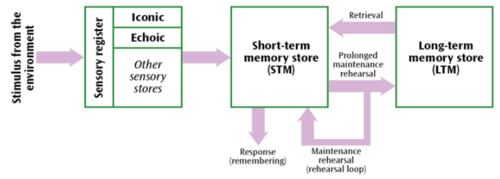2. multi-store model of memory
1/13
There's no tags or description
Looks like no tags are added yet.
Name | Mastery | Learn | Test | Matching | Spaced |
|---|
No study sessions yet.
14 Terms
what is the MSM
a representation of how memory works in terms of three stores called the sensory register, STM and LTM
describes how information is transferred from one store to another, what makes some memories last and what makes some memories disappear
atkinson & shiffrin
MSM diagram

in simple forms what does the MSM suggest
it suggests that memory is made up of three stores linked by processing
the sensory register
all stimuli from our environment pass into the sensory register, and there are several registers with one for each of our senses
coding, capacity and duration of the sensory register
CODING - it is modality specific (ie depends on the sense) in each store. the store coding for visual info is iconic memory, and the store coding acoustically is echoic memory
DURATION - very brief (less than half a second)
CAPACITY - very high for example there are over one hundred million cells in one eye, each storing data
STM
CODING - mainly acoustically
DURATION - lasts about 18s unless it is rehearsed so it is more of a temporary store
CAPACITY - limited, between 5 and 9 items of info though cowan’s research suggests it may be more like 5 rather than 9
maintenance rehearsal
it occurs when we repeat (rehearse) material to ourselves over and over again - we can keep info in our STM as long as we rehearse it
if we rehearse it long enough it passes into LTM
LTM
CODING - mainly semantically
DURATION - up to a lifetime
CAPACITY - practically unlimited
according to the MSM, when we want to recall info from LTM, it has to be transferred back into STM by a process called retrieval
evaluation
research support (& counterpoint)
more than one STM store
elaborative rehearsal
bygone model
research support
evidence supports idea that STM and LTM are separate stores
baddeley found that we mix up similar sounding words in STM but mix up words with similar meanings in LTM - suggests they use different coding systems, supporting the MSM
confirms the MSM claim that they are independent memory stores
counterpoint
research used artificial materials not reflective of real life memory use, lack ecological validity
studies used digits, word lists and meaningless consonant syllables rather than meaningful memories like names or faces
makes MSM less valid as a model of everyday memory, suggesting it may not accurately represent real world memory processes
more than one STM store
the MSM assumes STM is a single unit, but research suggests otherwise
shallice & warrington studied a client referred to as KF who had a clinical memory disorder called amnesia. found he has poor STM for verbal info but a normal STM for digits
indicates there are different STM stores for auditory and visual info, contradicting the MSM claim that it is a single, undivided store
elaborative rehearsal
MSM oversimplifies how info transfers to LTM
according to MSM what matters is the amount of rehearsal, but craik & watkins found the type of rehearsal is more important - said elaborative rehearsal (linking new info to existing knowledge) is more important than just repetition
suggests prolonged rehearsal alone does not ensure transfer to LTM, weakening the MSM explanation of how info moves between stores
bygone model
MSM is based on outdated research that does not fully explain modern memory understanding
research now suggests LTM is made up of different types (episodic, semantic, procedural) and is not just one unitary store
MSM is reductionist as fails to account for these distinctions, raising question of whether it is still a useful model of memory today